6 Reasons To Focus on Long Tail Keywords
Like many people, every day we enter dozens of queries into search engines, which have become part of our daily lives. When entering these queries, we might have many different purposes such as obtaining information, finding an address, buying a product, or accessing a website. The searches we enter for these purposes are sometimes short ones consisting of one or two words. On the other hand, in some cases we enter rather long tail keywords as they get more and more goal-oriented.
What Are Long Tail Keywords?
As webmasters or SEO consultants, we work on keywords almost every day. During these works, we can see that many different keywords have very interesting search volumes. However, with a few exceptions, the decrease in search volume is directly proportional to the increase in the number of keywords in a query. Keywords that are composed of one or two words and have usually high search volumes are called short tail keywords. Aside from those, keywords that are usually composed of three or more words and have lower search volumes are called long tail keywords. But although these keywords have low search volumes, research suggests that long tail keywords make up the majority of Google queries.

To explain with an example, the search for “shoes” is considered a short tail keyword, while the search for “nike shoes for men” is considered long tail keywords. When we look into our example, we see that the search volume of the “shoes” query is very high and the competition in that query is quite intense, while the user intent is more evident in the “nike shoes for men” query and the search volume is at a considerable level, even though it is low compared to the “shoes” query.

Why Are Long Tail Keywords Important?
When doing keyword research for a website and taking action after that, focusing on short tail keywords -which are always high in search volume- may not always be the right strategy. Focusing on these keywords, which are high in search volume and competition, can make it difficult to achieve success at the first stage for a non-authoritarian or a new website. So, it might make more sense to initially focus on long tail keywords, where competition is relatively low and user intent is much clearer. Let's look into why long tail keywords are important item by item.
1) Low Competition
Long tail keywords have lower search volumes than shorter and more generic keywords. The relatively low search volume usually causes the keyword in question to have proportionally lower competition. As you can see from the sample keywords below, the search volume decreases proportionally as the number of keywords increases in user queries containing the same words.

Its low search volume compared to shorter words may cause the word to lose its appeal for many people. But in addition to the low search volume, the keyword can often have lower competition as well. Lower competition in turn helps achieve the desired success with the right moves in a shorter time.
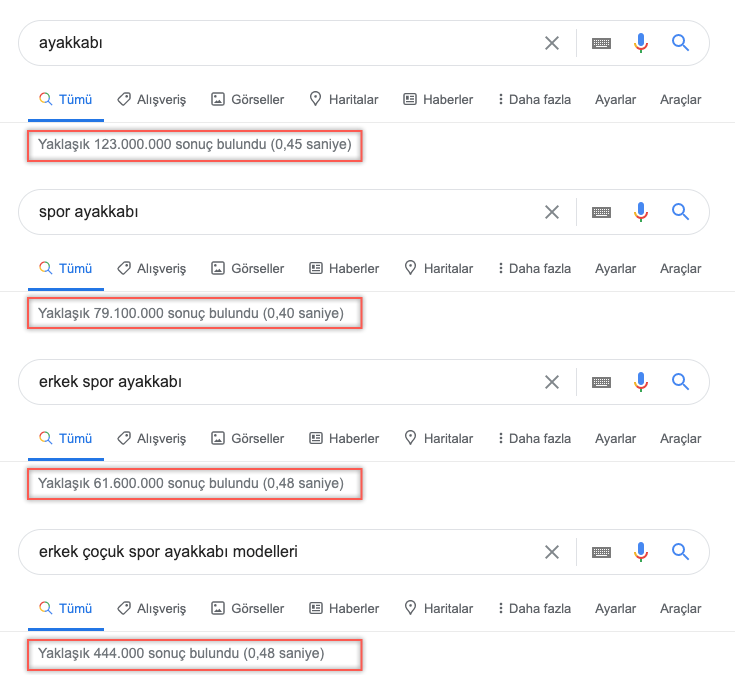
2) The Advantage of Conversion Rate
Long tail keywords contain more words as the name suggests, allowing users to give more details about their queries. The intent of users who search in more detail is also more evident than in other queries. For example, the user's intent in the “internet” query can be easily distinguished from the one in the "internet providers near me" query. In short, the user's aim is more evident with long tail keywords, so the desired conversion rates can be achieved more easily with accurate targeting and optimization work.
3) More Easily Targeted User
Queries called long tail keywords are usually considered to be more comprehensible than short tail keywords because they contain more words. For example, it is very difficult to understand the users' intent who enter the “headphones” query into the search engine. Because there are no specified details about the headphones, it might not be easy to target the user. However, we can say that the aim of the users who enter the "best noise cancelling headphones" query is quite clear compared to those who enter the "headphones" query. As you see in this example, usually users who enter long tail queries can be targeted more easily and more healthily by websites because they convey their goals more clearly.

4) A Strong Blog Strategy
We mentioned that long tail queries provide more detailed information about user intent because they contain more words. We also know that some of the long tail keywords are queries that contain interrogative words. For instance, the "how to clean white shoes" query could be a good example of long tail queries that could be targeted for the blog. You can get new users by developing strong blog strategies for long tail keywords that suit your website through a variety of keyword research tools. You can develop a strong blog strategy that could be useful for users by filtering queries that contain interrogative words such as “what, how” to obtain keywords more easily, as in the example.

5) The Position Zero Opportunity
It will come as no surprise to be rewarded by Google after a while when we create content that is more quality, original and comprehensive than our competitors. This will all be thanks to the blogging strategy we developed by focusing on long tail keywords. We might achieve position zero with our content -which usually includes lists or tables- on our pages where we target long tail keywords such as the following. This way, we can also get our competitors to rank even lower and draw most of the traffic to our website thanks to long tail keywords.
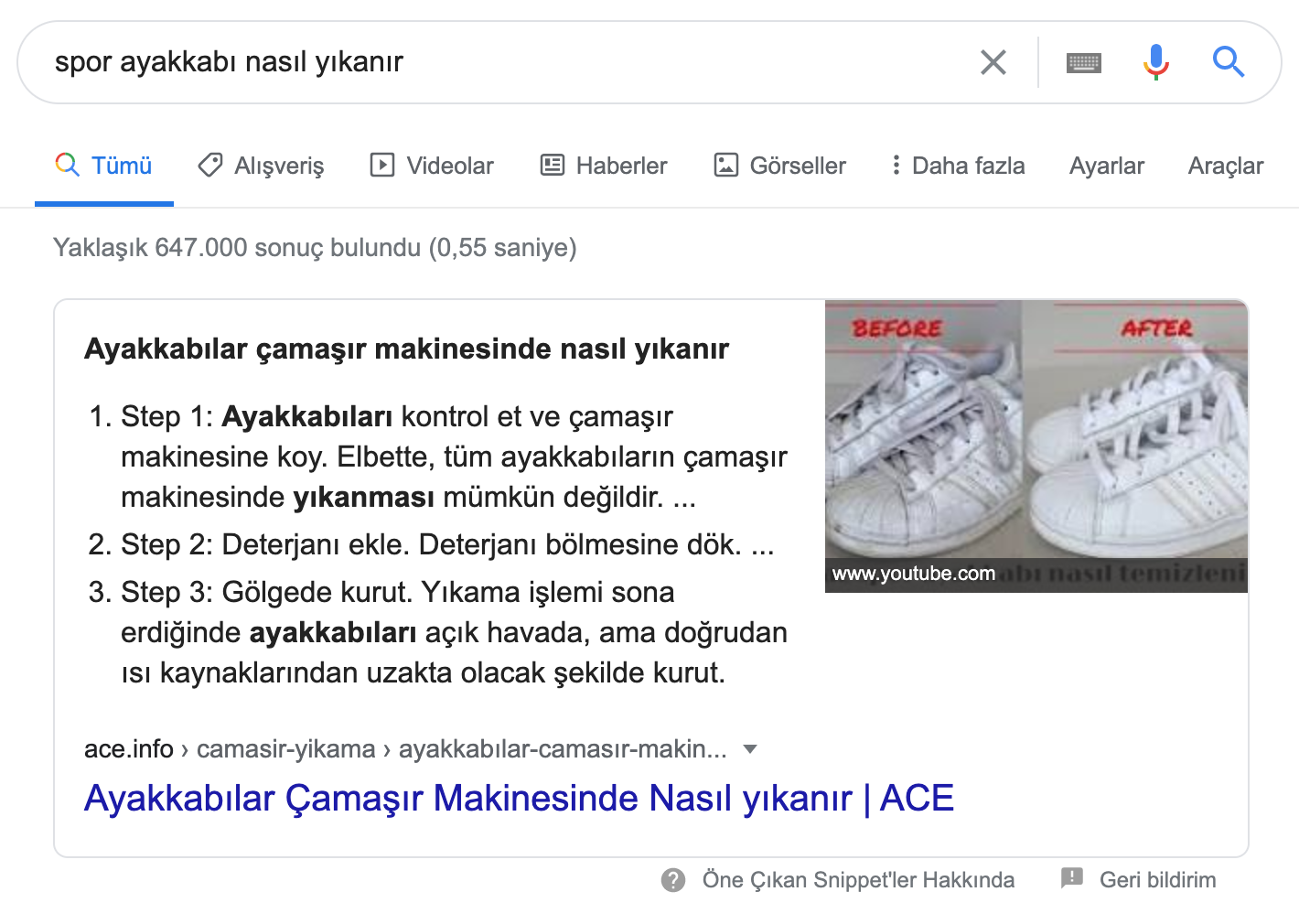
6) Success in A Shorter Time
Even though the long tail keywords we see above with their examples have less search volume than other queries, they have less competition as well. Less competition helps to achieve success with the right strategies. As we mentioned earlier, focusing only on queries with a high search volume for a new website will considerably extend the time it takes for your efforts to be rewarded. But when we target long tail queries correctly, we may have the opportunity to achieve success in a shorter time in return for our work.
How Can We Find Long Tail Keywords?
So far, we've looked into what long tail keywords are and why they are important. So how do we find these long tail queries that users enter? Let's take a look at various paid or free methods of doing research on long tail keywords together.
1) Keyword Research Tools
Thanks to tools like Ahrefs, SEOmonitor, SEMrush, Keywordtool, Ubersuggest, WordTracker, we can easily access a lot of information about keywords and their search volumes. For example; when we want to do some research on long tail keywords using the tool named Ahrefs, we firstly go to the "Keywords explorer" section of Ahrefs. We then do a research on the most generic short tail keyword and click “Having same terms” to access the queries containing the said keyword. Finally, we can easily filter the minimum and maximum number of words in the query with the "Word count" filter.
To proceed with an example, let's assume that we have a website about shoes. So, we can search for the “shoes” query, which is the most generic query related to our website. Then, when we click "Having same terms" and filter queries with a minimum of four words, we can easily find long tail keywords.
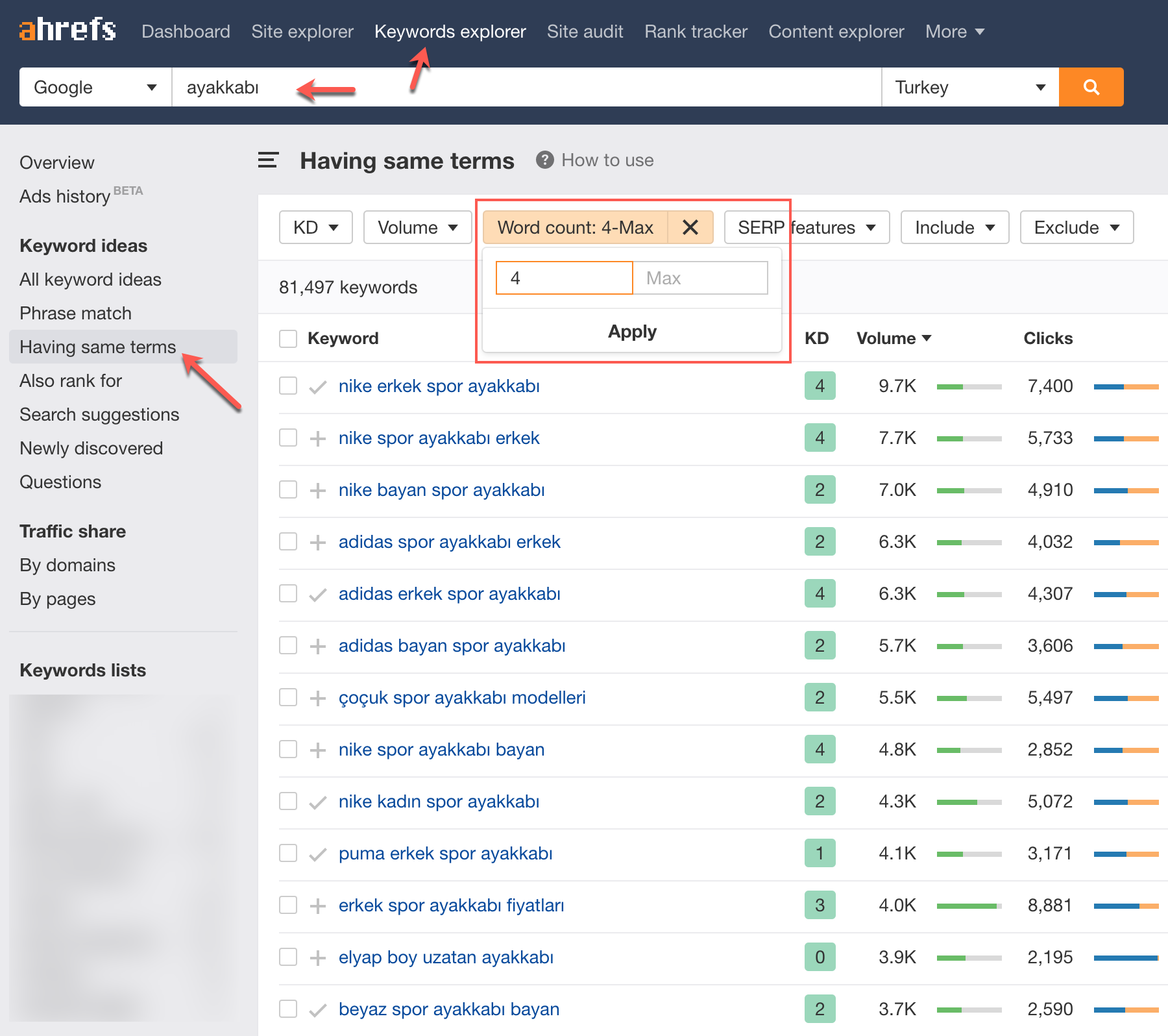
2) SERP Research
One of the easiest and most accurate ways to research long tail keywords that are related to our website is to use search engine results pages.
2.1) The Related Searches Section
First, we enter a query about the subject we want to research on Google. For example, when we search “sneakers” on Google, the "searches related to..." section at the bottom of the page may be one of the easiest ways to discover long tail keywords related to this subject.
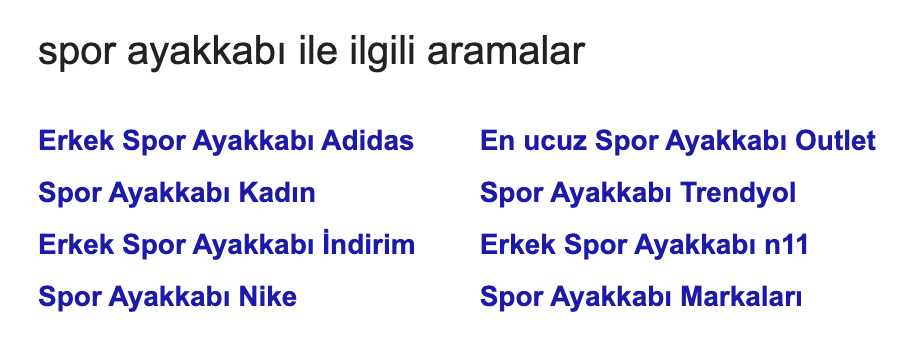
2.2) Google's Query Autocomplete Feature
To help us when entering a query into the search bar, Google offers suggestions that we can use to complete our query and that previous users have frequently completed. This field will also help us find long tail keywords.
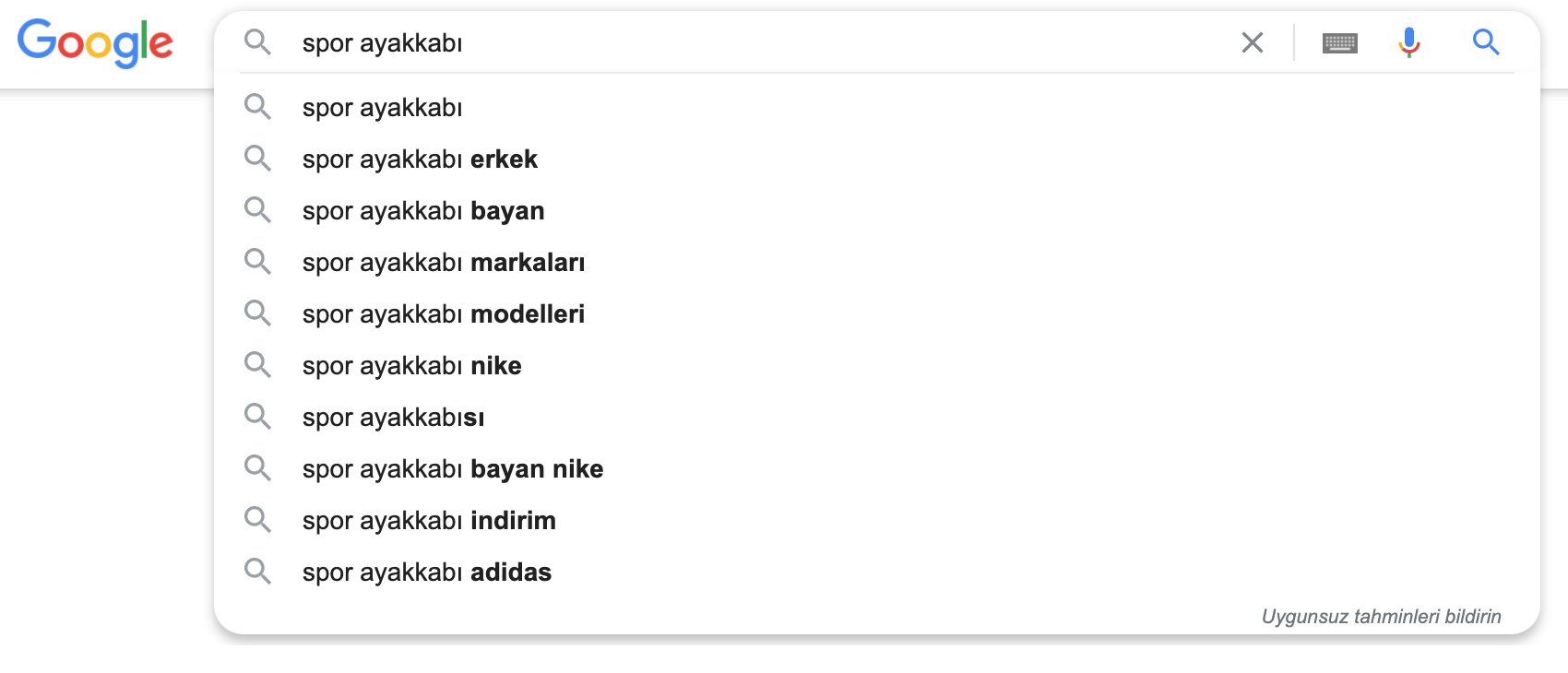
2.3 The "People also ask" box
This box, which we often encounter through queries with interrogative words, allows us to learn about the related questions other users search for. This allows us to easily find the long tail queries which users are curious about and which are related to the query.
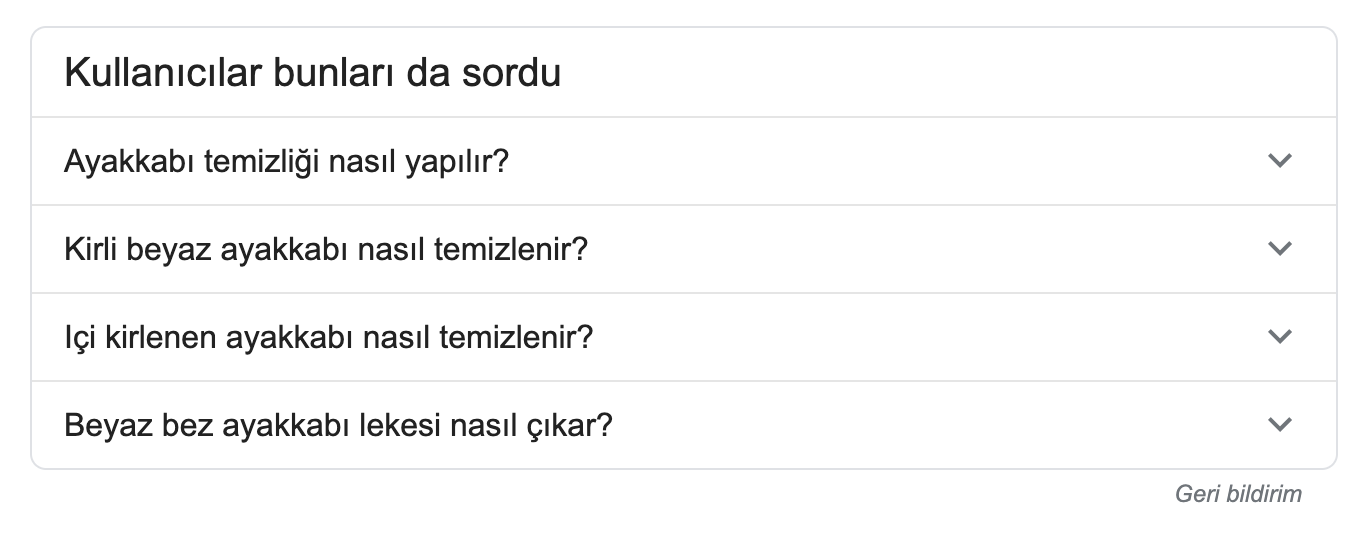
3) Google Services
We may also use Google's services if we want to do a research on long tail keywords outside of keyword research tools and search engine result pages. Thanks to the most commonly used tools like Google Search Console, Google Trends and Google Adwords Keyword Planner, we can still do research on long tail keywords.
4) Forums and Direct Questions of Users
We can also do research on long tail keywords indirectly through forums that are related to our website or platforms where users ask questions in some way. For example, for a brand operating in the internet industry, we can examine the topics that are frequently opened in tech forums. With these topics, we can learn which subjects the targeted users are most interested in or what issues they have. Then, it would be wise to create user-friendly content to address these questions or issues.
How Can We Target Long Tail Keywords?
The process after completing our research on long tail keywords is also very important. We can talk about two main methods to target these user queries.
1) Specific Pages for These Long Tail Queries
It would be one of the most logical moves to create pages where we can directly target long tail keywords with a considerable search volume. For example, the “how to clean white shoes” query we encountered above would be a very good example of long tail keywords which are worth searching for and can be targeted directly. When we look at the results page for the said query, we already see that many websites target the query directly.

2) Supporting Short Tail Keywords
In addition to targeting directly, another way to use long tail keywords is to support words with a high search volume. For example, we know that the word "sneakers" has a quite high search volume and competition. We can often find that our competitors have quite comprehensive content for keywords like these. In order to be successful in these queries, we might also need to create a comprehensive set of informative content for users. When creating comprehensive content, we can also extend the scope of our content by using long tail keywords with the related keyword as subheadings. Our comprehensive content full of long tail keywords can help us rank above our competitors in the related keyword.
We examined together what long tail keywords are, why they are important, how they can be found and targeted. I hope this was explanatory and helpful. :)
















